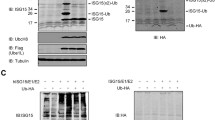Abstract
MyoD is a tissue-specific transcriptional activator involvd in skeletal muscle differentiation. It is induced during transition from proliferating, non-differentiated myoblasts to the resting and well differentiated myotubes. Like many other transcriptional regulators, it is short-lived, however, the targeting proteolytic pathway and the underlying regulatory mechanisms involved have remained obscure. Here we show that MyoD is degraded by the ubiquitin system both in vivo and in vitro. In cells, degradation is inhibited by lactacystin, a specific inhibitor of the 20S proteasome. Inhibition is accompanied by accumulation of MyoD-ubiquitin conjugates. In a cell free system, the proteolytic process requires both ATP and ubiquitin and is preceded by formation of MyoD-ubiquitin adducts. Interestingly, the process is inhibited by the specific DNA sequence to which MyoD binds. Analysis of the ubiquitination site has revealed that the N-terminal residue of MyoD is sufficient and essential to promote conjugation and subsequent degradation of the protein: conjugation to internal Lys residues is not necessary. Substitution of all Lys residues did not affect significantly its degradation either in intact cells or in a reconstituted cell free system. Degradation was inhibited by specific proteasome inhibitors and was accompanied by accumulation of ubiquitinated species of the protein. We concluded that the first ubiquitin moiety is attached via its C-terminal Gly to the N-terminal residue of MyoD, and the polyubiquitin chain is then synthesized on Lys48 of this moiety.
Similar content being viewed by others
References
Davis RL, Weintrau B H & Lassar AB (1987) Cell 51: 987–1000
Weintraub H, Davis R, Tapscott S, Thayer M, Krause M, Benezra R, Blackwell TK, Turner D, Rupp R, Hollenberg S, Zhuang Y & Lassar AB (1991) Science 251: 761–766
Weintraub H (1993) Cell 75: 1241–1244
Olson EN & Klein WH (1994) Genes Devel. 8: 1–8
Murre C, McCaw PS, Vaessin H, Caudy M, Jan LY, Jan YA, Cabrera CV, Buskin JN, Hauschka SD, Lassar AB, Weintrub H & Baltimore D (1989) Cell 58: 537–544
Benezra R, Davis RL, Lockshon D, Turner DL & Weintraub H (1990) Cell 61: 49–59
Sun XH, Copeland NG, Jenkins NA & Baltimore D (1991) Mol. Cell. Biol. 11: 5603–5611
Langlands K, Yin X, Anand G & Prochownik EV (1997) J. Biol. Chem. 272: 19785–19793
Thayer MJ, Tapscott SJ, Davis RL, Wright WE, Lassar AB & Weintraub H (1989) Cell 58: 241–248
Ciechanover A (1998) EMBO J. 17: 7151–7160
Hershko A & Ciechanover A (1998) Annu. Rev. Biochem. 67: 425–479
Hochstrasser M (1996) Annu. Rev. Genet. 30: 405–439
Coux O, Tanaka K & Goldberg AL (1996) Annu. Rev. Biochem. 65: 801–847
Deshaies RJ (1995) Trends Cell Biol. 5: 428–434
Varshavsky A (1992) Cell 69: 725–735
Johnsosn ES, Bartel B, Seufert W & Varshavsky A (1992) EMBO J. 11: 497–505
Yu H, Kaung G, Kobayashi S & Kopito R (1997) J. Biol. Chem. 272: 20800–20804
Murakami Y, Matsufuji S, Kameji T, Hayashi S-i, Igarashi K, Tamura T, Tanaka K & Ichihara A (1992) Nature 360: 597–599
Hershko A, Heller H, Eytan E, Kaklij G & Rose IA (1984) Proc. Natl. Acad. Sci. USA 81: 7021–7025
Brandimarti R & Roizman B (1997) Proc. Natl. Acad. Sci. USA 94: 13973–13978
Author information
Authors and Affiliations
Rights and permissions
About this article
Cite this article
Ciechanover, A., Breitschopf, K., Hatoum, O.A. et al. Degradation of MyoD by the ubiquitin pathway: regulation by specific DNA-binding and identification of a novel site for ubiquitination. Mol Biol Rep 26, 59–64 (1999). https://doi.org/10.1023/A:1006964122190
Issue Date:
DOI: https://doi.org/10.1023/A:1006964122190




